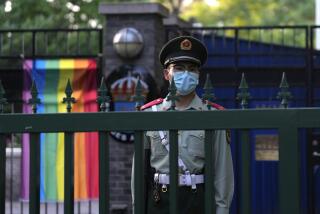Ai Weiwei: imprisoned but not silenced
There are artists who prefer to stay out of the public spotlight and devote themselves solely to their work. And then there is Ai Weiwei.
An Internet activist with a history of getting into trouble with Chinese authorities, Ai has been outspoken in support of free speech and human rights. He spent 81 days in jail this spring before being released on bail but still faces charges related to tax evasion — charges supporters regard as an attempt by the government to silence him.
The terms of Ai’s release forbid him from discussing his legal case. But on Friday, Ai spoke by phone from Beijing about his artwork, specifically his touring installation “Circle of Animals / Zodiac Heads,” which opens Saturday at the Los Angeles County Museum of Art and runs through February.
The artist, 54, was clearly in a chatty mood and the conversation touched on his health and even his recent return to Twitter.
Ai won’t be able to attend the opening of “Circle” at LACMA because he is confined to Beijing as part of his bail arrangement. “Circle” features large-scale statue heads of the Chinese zodiac and is inspired by those at China’s Yuanming Yuan palace, which was pillaged by British and French military forces in 1860.
“It’s about the future and the past, and how China is looked at today and how it looks at itself,” explained Ai. “It has many, many different layers — is it art or not art, and to what degree?”
In 2009, Chinese officials attempted to halt the auction of two of the original heads that had been owned by fashion designer Yves Saint Laurent. The sale was regarded by some as an affront to China’s cultural identity.
In his work, Ai re-creates some of the known statue heads and invents others, his installation fusing the old with the contemporary while playing with the notion of fakery versus authenticity — which he has explored extensively.
Ai said the installation should appeal to a wide range of people, including those who have no art background. “I wanted it to relate to the general public,” he explained. “Art is a way of communication. It should be shared by an audience. I’m always trying to find a way to make the message more relatable to our daily lives.”
Ai, who suffers from hypertension and diabetes, described his health as generally good. “My blood sugar and blood pressure were not normal before I was detained. Now they have become very normal to a degree,” he said from the Beijing compound where he lives and works.
The artist said he lost about 26 pounds while in detention and has gained back a little more than 6 since his release.
In 2009, Ai underwent brain surgery after suffering a beating at the hands of police. His recent stint in detention didn’t help matters; he said that he has problems focusing on tasks for extended periods.
“I cannot do long reading ... [and] I cannot concentrate very well. But maybe that will be nice for an artist,” he said.
This month, Ai returned to Twitter for the first time since his release and has posted a number of political messages, in violation of his release agreement. The artist hesitated when asked about this but offered a few words of explanation.
“Twitter is not allowed, of course,” he said. “I can’t talk about my case. I have broken some rules, but I have to take the consequences. I have been warned again.”
The art world rallied to Ai’s defense after his arrest, in public demonstrations and appeals to the Chinese government. Ai said he was surprised by the amount of media coverage that his case generated, but he was quick to downplay his own importance.
“This event isn’t about me but about the whole society. It’s about how people are being treated,” Ai said. He added that he continues to support “freedom of expression and the Internet, and how people can communicate and share ideas through the Internet.”
Those who know Ai say he is trying to observe the rules of his release.
“Ai is trying to be respectful of his situation and remains conscious of the past six months. But Ai Weiwei is Ai Weiwei,” said Larry Warsh, a colleague and the head of AW Asia, the New York group that organized the “Circle” tour. The installation opened in New York and London while the artist was in detention.
Warsh said L.A. is the first exhibition of “Circle” in which Ai is able to communicate and discuss his art. “We all feel that he has a limited voice right now, but that will change.”
Ai is one of a number of prominent Chinese cultural figures who are active in the realm of human rights. Other activists include the Nobel Peace Prize-winning author Liu Xiaobo, currently in prison, and artist Wu Yuren — nicknamed “Little Ai” — who also has spent time in jail.
Michael Govan, the director of LACMA, visited Ai at his Beijing studio before the April arrest to discuss the possibility of a collaboration. “Ai is a big man, in several ways. He exudes a kind of generosity of spirit. It’s clear no one is pushing him around,” said Govan.
Ai lives with his family, including his wife and young son. He said life is returning to a semblance of normality. On Friday, the artist was somewhat preoccupied with a missing cat, one of many that he keeps on his compound. “This cat always wants to escape. He’s a very smart cat,” he said. “I don’t know if I should congratulate him or keep worrying.”
In art circles, Ai is known for his impish sense of humor. One of his best-known photographic series features a middle finger raised at various national monuments around the world.
Ai said his sense of humor has helped him endure the last few months: “Humor is important. It helps you deal with immense pressure and uncertainty. It brings you back to the ordinary.”
The artist concluded the conversation with a few words to American viewers who may be experiencing his work for the first time.
“I think they have to see it as something that will be removed after a period of time. It won’t be permanent. It will be there and then it won’t be there,” he said. “And enjoy the weather. Be healthy and happy.”
More to Read
The biggest entertainment stories
Get our big stories about Hollywood, film, television, music, arts, culture and more right in your inbox as soon as they publish.
You may occasionally receive promotional content from the Los Angeles Times.







